Safeguarding the Biodiversity Associated with Local Foodways in Traditionally Managed Socio-Ecological Production Landscapes in Kenya(SITR7-10)
14.03.2023
SUBMITTING ORGANIZATION
Bioversity International
DATE OF PUBLICATION
06/2022
REGION
Africa
COUNTRY
Kenya
KEYWORDS
Socio-ecological production landscapes · Foodways documentation · Underutilised local foods · Conservation · Human nutrition and health · Community involvement · Multi-stakeholder, Multidisciplinary interventions · Kenya
AUTHOR(S)
Patrick Maundu and Yasuyuki Morimoto
LINK
Abstract
Traditionally managed socio-ecological production landscapes (SEPLs) provide communities with a range of goods and services vital for livelihoods, including nutrition and health. In Kenya, many of these landscapes, encompassing the resources therein and the indigenous knowledge vital for optimising their value, are now under threat. Utilising diverse traditional foods for the benefit of local communities has often been hampered by insufficient knowledge about the foods and negative attitudes towards them. For over two decades, a team from the National Museums of Kenya, Bioversity International, and their partners has been working with local communities to find out how local food resources can contribute more to community livelihoods, especially with regard to nutrition, health, and income. Understanding local food systems is a vital step. The team developed a methodology for involving local communities, and the youth in particular, to inventory their foodways. The documentation opened opportunities for research and development interventions. This chapter highlights three development and conservation case studies founded on foodways documentation: (1) promoting African leafy vegetables in Kenya; (2) safeguarding kitete (bottle gourd) by Kyanika Women’s Group in Kitui, Kenya; and (3) utilising digital technology to educate consumers about healthy eating using local foods. All cases have shown that converting underutilised local foods into main sources of nutrition and income opportunities, as well as conserving these foods in their environment, requires foodways documentation, community participation, and multi-stakeholder and multidisciplinary collaboration. Awareness on the nutritional and health benefits of local foods was a key incentive for their conservation and a catalyst for the change in attitudes and eating habits.
1 Introduction
In Kenyan rural community food systems, a huge diversity of food species, especially fruits and vegetables, are obtained from the immediate environment or socio-ecological production landscapes (SEPLs), where they may be cultivated, semi-wild (cultivated and also wild), or gathered from the wild. The high diversity is found at landscape, food group, species, and below-species levels. In addition, a rich food cultural heritage—including local knowledge of food production and utilisation, beliefs, oral traditions, ceremonies, and other practices—exists as part of these food systems and constitutes the foodways of the communities. Food is therefore not only for nutrition, but also for the well-being of the community as a whole, and thus is inextricably linked with the landscape.
A high diversity of underutilised traditional foods can be seen in African leafy vegetables (Maundu et al., 2009). Foodways documentation by the National Museums of Kenya (NMK) and Bioversity International in collaboration with local community groups recorded about 220 vegetable species used by various communities in Kenya (Maundu et al. 1999a, b; Kilifi Udamaduni Conservation Group, 2010). Of these, 90.9% were gathered from the local wild landscape (Fig. 10.1). In spite of this native diversity, a few exotic vegetable species have dominated the Kenyan market and kitchen in the recent past.
Indigenous food systems in Kenya have been undergoing continuous disruptions since the colonial era. Traditional foods were looked down upon as foods of the poor and less modernised. This attitude and the associated stigma led to neglect by researchers and development workers. Consequently, the use of these foods decreased, leading to erosion of local food diversity and the associated local knowledge.
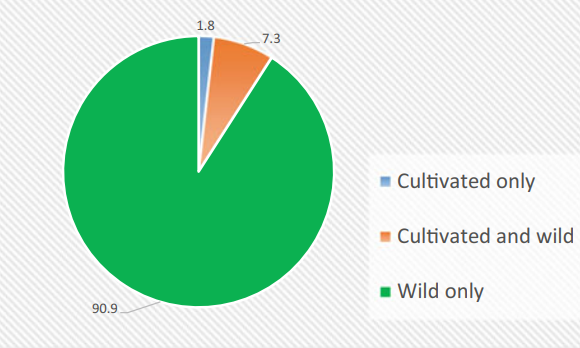
By the year 2000, the diversity of leafy vegetables in the market and diet had been narrowed considerably, typically to three vegetables—cabbage, kale (sukumawiki), and Swiss chard (“spinach”). Traditional vegetables were mainly sold in very rural towns and backstreets of main cities. Fast “junk” foods such as potato fries were slowly replacing the healthier traditional cuisine, and younger people were increasingly inheriting less local knowledge from their communities. Such trends had the potential to lead to loss of local crop varieties, less dietary diversity, and hence food and nutrition insecurity (Maundu et al., 2008; Johns et al., 2013; Kariuki et al., 2013; Induli, 2019a).
1.1 Changing Diets and the Double Burden of Disease
Kenya, like many other African countries, now has the simultaneous problems of undernutrition (e.g. stunting in children) and over-nutrition. Stunting in children under 5 years in 2008–2012 was at 35.3%, reducing to 26% by 2014 (from Kenya Demographic and Health Survey 2014 in KNBS , 2014). On the other hand, lifestyle diseases such as high blood pressure, heart disease, and diabetes were on the rise. The prevalence of overweight and obesity among women of reproductive age (15–49 years) was 33% in 2014 (Kenya National Bureau of Statistics (KNBS), 2014) and on the rise. Rapid changes in dietary habits including high intake of carbohydrates, lipid-rich diets, low intake of micronutrients, and insufficient exercise are considered to be the main contributing factors. The urban population was most affected mainly due to overreliance on relatively cheaper, high-energy refined foods. The 2014 survey established that 28.6% of women from the urban population were overweight, and 14.9% were obese, whereas among women from the rural population, 18.9% were overweight and 7.1% were obese (Mkuu et al., 2018; Kenya National Bureau of Statistics (KNBS), 2014).
1.2 Interventions by a Multi-stakeholder, Multidisciplinary Team
In an effort to arrest the trends mentioned here, a multidisciplinary team from the National Museums of Kenya, Bioversity International, and partner institutions has been for the last two decades implementing a series of activities aimed at achieving the following: (1) safeguarding local food systems, (2) creating opportunities for community benefits, and (3) creating awareness about the value of local foods. Fundamental in this process is the documentation of the foodways of communities. With understanding of foodways, various development interventions based on opportunities offered by local food resources can be implemented (Induli et al., 2020). The following case studies of development initiatives are highlighted in this chapter: (1) African leafy vegetable (ALV) research and promotion, (2) bottle gourd (kitete) conservation, and (3) using modern technology to educate consumers on the nutritional and health value of local foods. A common objective of these initiatives has been finding incentives for communities to utilise these local food resources to improve their livelihoods while sustaining the landscapes from where these foods are obtained or grown. Understanding the benefits of these food resources, including nutrition and health, and also discovering new value through research collaboration, can motivate the communities to promote their local foods (Induli et al., 2020; JAICAF, 2020).
The objectives of this chapter therefore are firstly to demonstrate via these case studies the role of foodways documentation as a basis for developing interventions for biodiversity conservation and development at the community or landscape level, and secondly to demonstrate the importance of community participation and multi-stakeholder cooperation in finding ways to optimise the value of such resources as an incentive for conservation. Also highlighted in the chapter are the conditions necessary for the success of such interventions, key lessons learned, and shortcomings.
2 Activities (Methods)
2.1 The Foodways Documentation Method
In this section, we start on the premise that among Kenyan rural communities, food is diverse and not only cultivated, but also picked from wild environments, and that local knowledge is a prerequisite to optimising benefits gained from these resources. Much of this knowledge on food diversity is undocumented, making food-based and conservation interventions hard to implement. A logical starting point, therefore, would be to find answers to these questions: What foods are cultivated or gathered, from where, when, and by whom? How is the food source managed? How is the food harvested and utilised? Is it stored or sold? How is it prepared and eaten and who eats it? What do people say about its value to the body? Is it used in ceremonies or rituals and what are related beliefs or taboos? These are important questions in foodways documentation.
This approach is unique in two aspects. Firstly, it captures the totality of knowledge and practices related to food within a given community, and therefore results in a nearly complete inventory of food species used as well as ways of utilisation. Secondly, the documentation is executed by community members. Such documentation helps us understand the important place of the local landscape in people’s food systems and resilience for food security and nutrition (Hama-Ba et al., 2016, 2017). In Kenya, traditional foodways are being eroded at a high rate due to global trends such as globalisation of food and urbanisation, which are not only detaching the youth from rural landscapes and from sources of local knowledge, but also changing their preferences and values concerning food. Building the capacity of the youth, alongside that of other community members, to take the lead in foodways documentation helps bridge the intergenerational gap in the knowledge of local resources, a key ingredient in the sustainability of conservation interventions. Documentation provides the basic information necessary for other local resource-based intervention initiatives and also gives us the opportunity to recreate the foodways in the future in case the knowledge in the community is lost.
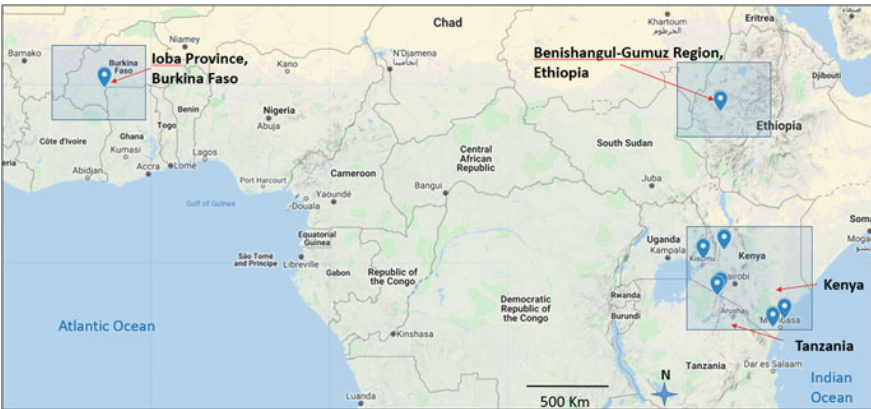
For a number of years, the authors have been developing a foodways documentation method that is community-led and involves the youth. The method has so far been tested in six communities across four African countries—the Mijikenda, Isukha, and the Pokot of Kenya; Loita Maasai of Kenya and Tanzania; Gumuz of Ethiopia; and Dagara of Burkina Faso (Figs. 10.2, 10.3, 10.4, and 10.5). Some basic information about these communities is presented in Tables 10.1, 10.2, and 10.3.
Documentation by Community Members
Selected community members are trained on foodways documentation. The basic materials needed for documentation include a notebook, a simple camera with video facility, or a smartphone and storage facility like a computer. A community coordinator or champion monitors the documentation process, gathers the collected information, and keeps it at a community resource centre or an institution within the community. This was the system applied among the Gumuz and Dagara. It is recommended that documentation goes on for a period of one year or more to capture variation through different seasons.
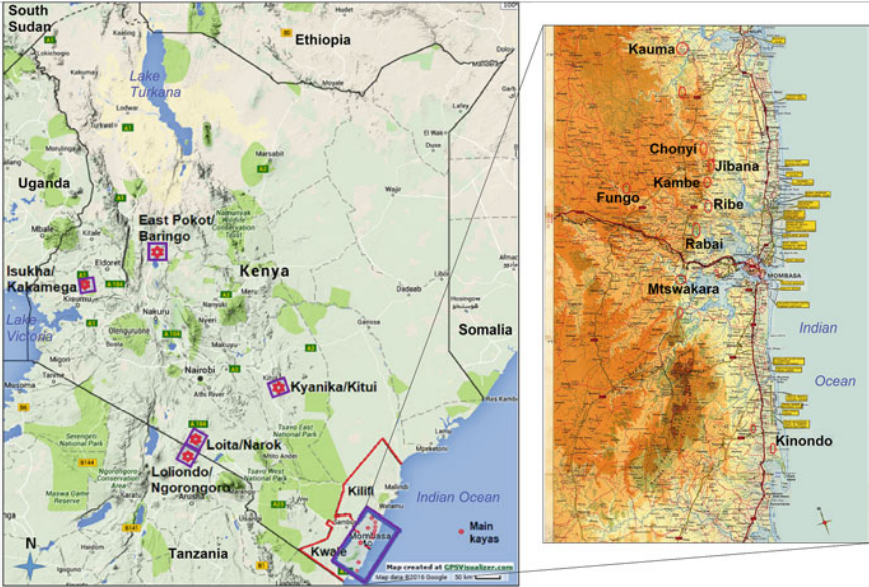
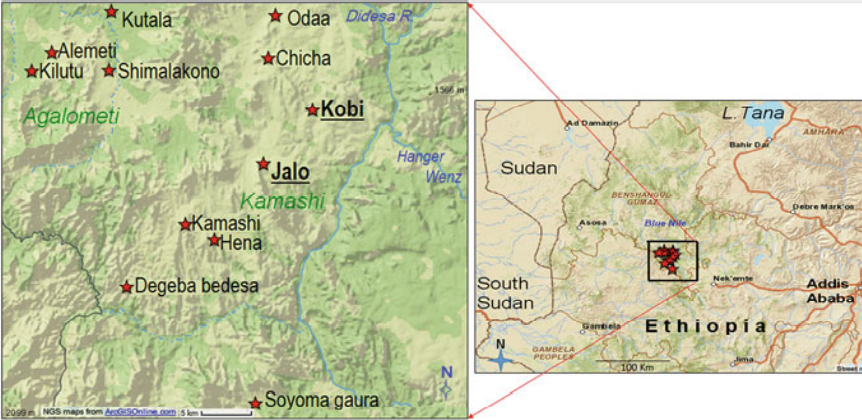

Foodways Documentation by Schools
A most effective approach is mobilising and training the youth, including school children, to gather information from their parents and relatives and sharing this, for instance, using social media or with fellow pupils and their teachers. Documentation by school pupils has been done in four communities—the Isukha, Pokot, Mijikenda, and Maasai. Except for the Mijikenda, where nine schools were involved, two schools participated per community (Induli, 2019b). In each school, two or more teachers volunteer to guide the pupils. Teachers could also be patrons of a school club. One teacher coordinates all the activities at a school. The teachers are trained by a multidisciplinary team in information gathering, including interviewing, organising the stories, how to use a camera, and handling data from pupils (e.g. preparing photo metadata, putting on captions, annotations, and attributions). The teachers in turn train the participating pupils. In most schools, participating pupils were 10–14 years old, and the number of pupils was such that the teachers could manage the group when reviewing foodway stories and also while on outdoor activities.
Each pupil in consultation with the teacher chooses a topic to research. The topic could be about a plant product, e.g. a fruit. The pupil then goes and gathers all available information in consultation with parents and relatives. The pupil takes photos and videos of various activities related to the food. The pupil then writes an essay about his or her topic, making illustrations where possible, and brings it to the teacher for assessment. The length of this essay is flexible, and it is written in alanguage agreed upon with the teacher. The pupil gets feedback from the teacher to improve the essay. The pupil also works with the teacher to write captions for selected photos.
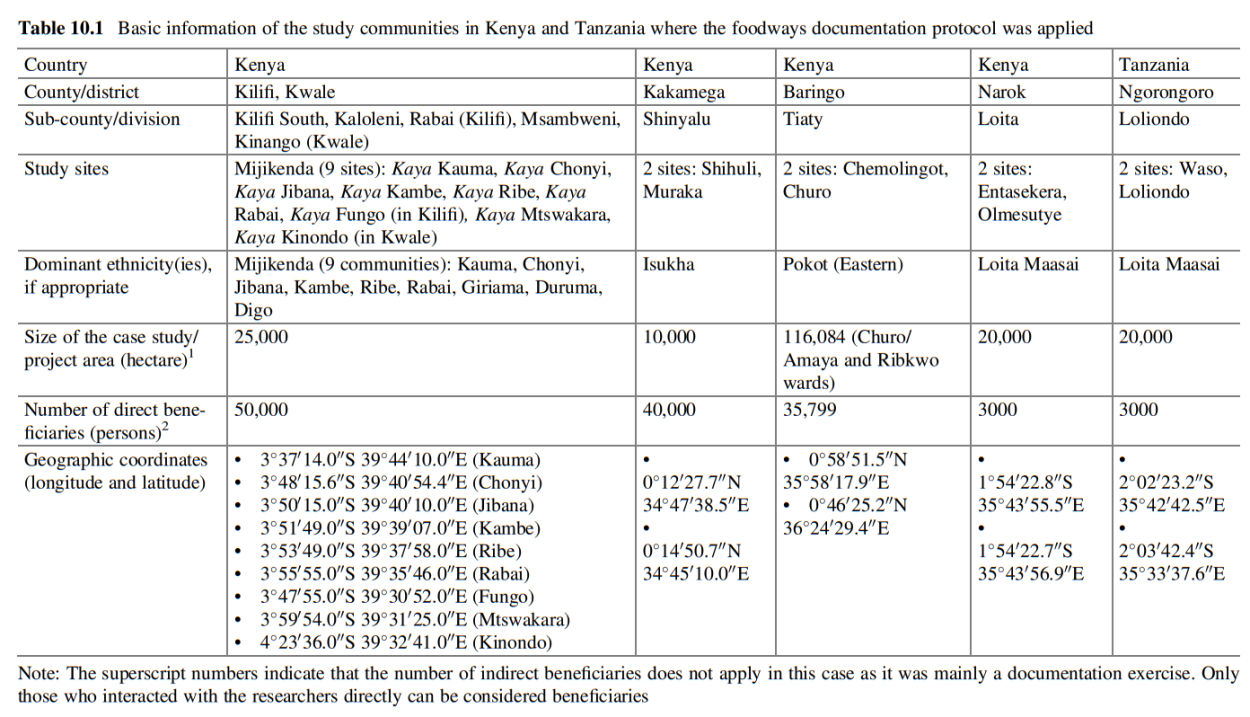
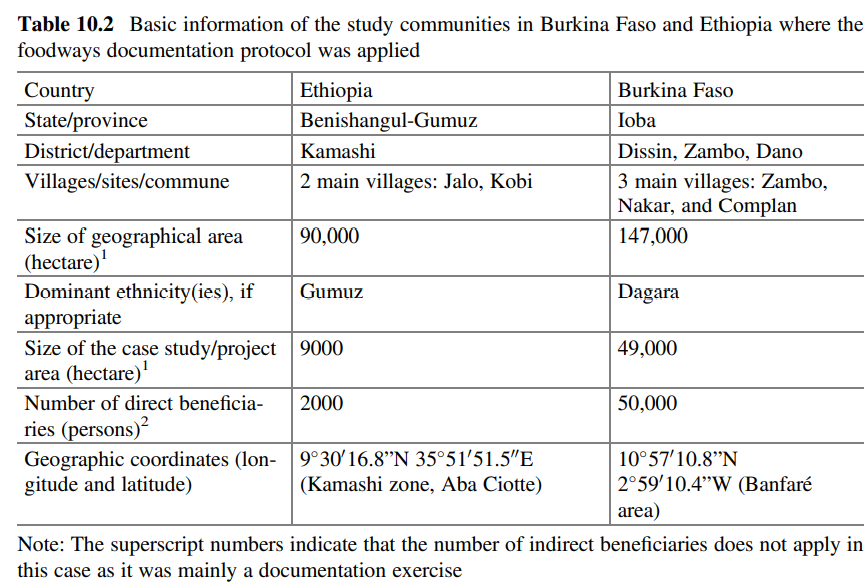
The teachers read all essays, looking at not only the content, but also the grammar and style. The teachers are also the custodians of cameras. They keep all records, including copies of completed pupils’ essays. Teachers also ensure that the pupil’s name, age, class, school, date, and topic appear on the top of the pupil’s essay and that all pages are numbered. The following are some key topics pupils covered during their interactions with family members:
- Local names of the food
- Description of the food
- Description of where it is found and/or grown
- Management in the field
- The process of harvesting or gathering
- Preparation or recipes
- Cultural aspects: myths, beliefs, taboos, etc.
- Other uses and any other information
- Seasonal availability
- Trends in utilisation
- Tools and equipment
The pupils are also guided by questions about what, who, why, when, where, and how, at every stage of compiling their essays. The multidisciplinary team also plays a key role by providing scientific input including nutritional information and scientific names. The team also ensures that the same information is archived and shared with a national repository according to
terms agreed upon with the community. The team works closely with the community to identify opportunities for using their knowledge and food resources to improve their livelihoods. Standard consent procedures are followed when dealing with the community.

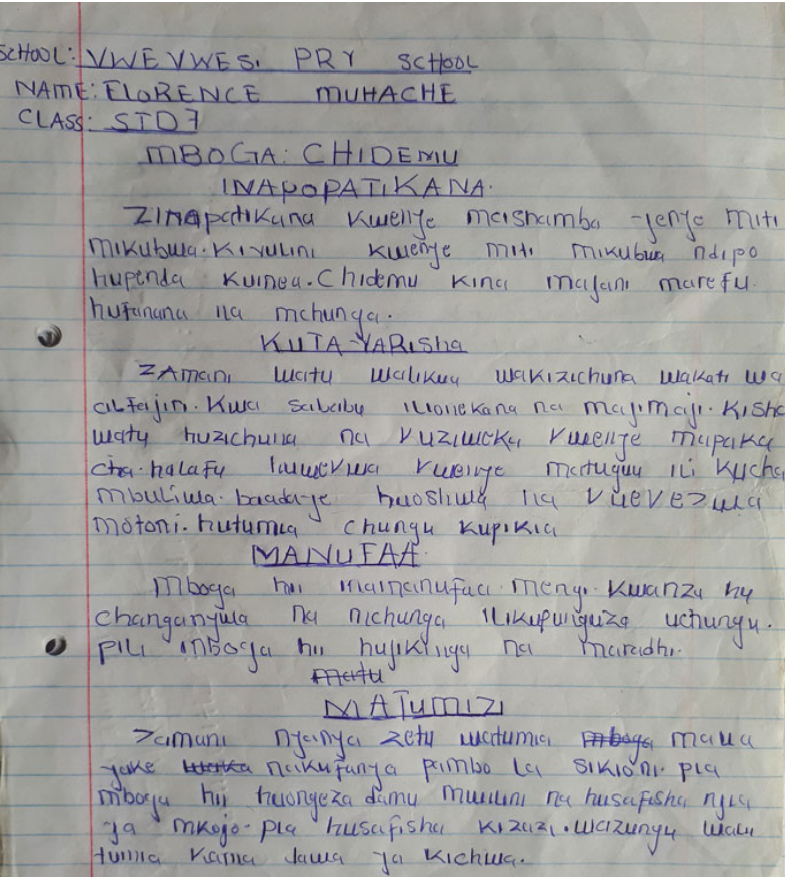
A typical pupil’s essay is provided in Fig. 10.6. In all cases, and as expected,
pupils gave priority to their main foods. In the pastoralist Pokot for example, the community gave priority to livestock diversity and food gathered in the wild, while those in the agricultural Isukha gave priority to cultivated foods. Among the foods of the Loita Maasai, milk (the most important Maasai food) had the highest frequency constituting over half of the 450 essays recorded by the two schools involved. About 1000 essays were written by the pupils from the Mijikenda schools over 18 months.
The main challenges faced concerned language and the use of cameras. Maasai pupils preferred to write in their local language (Maasai), while Mijikenda pupils preferred Swahili. This meant engaging translators. In some schools, photos were not taken as school teachers would not entrust pupils with cameras. In most communities, documentation by schools was augmented by simultaneous documentation work by trained community youth. The combined information from the community and pupils resulted in a rich document about food resources from the local landscape. Some potential outputs of the foodways documentation can be:
- An inventory of traditional foods of a community and indigenous knowledge
about them - Identification of season of availability
- Identification of local recipes
- Identification of food taboos, beliefs, and ceremonial use
- Recognition of the value of a food species to a community
It is evident from Table 10.1 that the people relied on many species obtained from the immediate natural environment. Dependence on wild resources seemed to be particularly high among pastoralists and communities with gathering practices. The foodways documentation among the Isukha and the Pokot was published in three volumes which are now accessible on the internet (Maundu et al. 2013c,b,c,d).
Follow-Up Development and Conservation Activities
Documentation should not be a stand-alone activity. It should pave the way for community development activities based on the local knowledge and resources. Such activities help communities to treasure their knowledge and resources. The following three cases demonstrate the kind of development projects that can follow documentation.
3 Cases Studies
Each of the three cases presented here has documentation, development, and conservation aspects. In all cases, foodways documentation has proved useful in the development and execution of the activities.
3.1 Case Study 1: African Leafy Vegetables (ALVs) Research and Promotion
Phase I
The main drive to bring back African leafy vegetables (ALVs) to the Kenyan menu started in 1995, and involved a consortium of institutions brought together by the International Plant Genetic Resources Institute (IPGRI). Key partners were the National Museums of Kenya (NMK) and local universities. During the first phase, 1995–1999, local production systems, associated indigenous knowledge, and local use of the ALVs were documented using many aspects of the foodways documentation method. The documentation in this phase not only laid a base for future work but also selected 24 priority vegetables (out of 220 documented) for further research and promotion (Fig. 10.7).
At the end of the first phase, key areas of follow-up were identified, including increasing awareness in the general public; collecting seeds of priority species; improving seed systems; developing protocols for cultivation; linking farmers to markets; documenting recipes; and conducting nutritional analysis. This guided the preparation of the second phase.
Phase II
In this phase between 2001 and 2006, the multi-stakeholder group of partners was expanded to include government ministries, national research institutions, non-governmental organisations (NGOs), community-based organisations (CBOs), and more universities. The team embarked on improving people’s perceptions of local vegetables through promotional activities based on scientific evidence. Nairobi City, the commercial hub, was strategically chosen for promotional activities, firstly because it has people from various ethnic communities (hence has a ready market for a variety of species) and secondly, what goes on in the capital eventually trickles down to the rural areas. Farmers in Nairobi’s peri-urban agricultural areas were particularly targeted for the production of traditional vegetables. The fact that most traditional vegetables are highly nutritious proved helpful during promotional campaigns. Promotional activities took the form of cooking demonstrations, street and media campaigns, field days, posters, and leaflets providing recipes and nutritional benefits of the food (Figs. 10.8 and 10.9). By 2003, a change was noticeable. The negative attitude among vegetable consumers had begun to crumble. Traditional vegetables started to flood through both formal and informal markets, opening income-generating opportunities for farmers and traders who are mainly women. Farmers had a reason to conserve the species and their landscapes (Maundu et al., 2008).
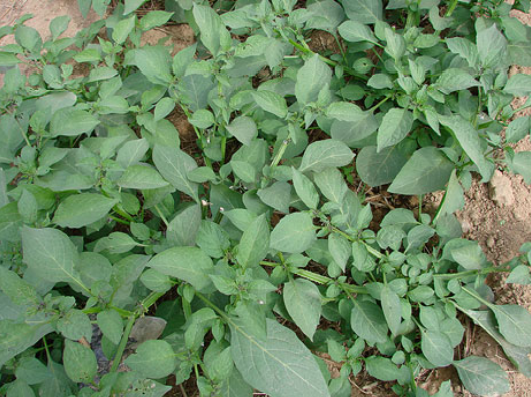

Alongside promotional work, the project gathered germplasm, some of which underwent selection work for improvement at the World Vegetable Centre facilities in Arusha, Tanzania. Improved seeds were distributed to farmers and seed companies. Farmers around Nairobi were given agronomic support and linked to formal markets, initially Uchumi Supermarkets, one of the main supermarket chains at the time. By 2006, consumption had increased, creating unprecedented demand (Gotor & Irungu, 2010). Most households in and around the city of Nairobi incorporated traditional vegetables in their diets. Supermarkets started to sell the vegetables while street vendors flooded some streets with the vegetables (Figs. 10.10 and 10.11).
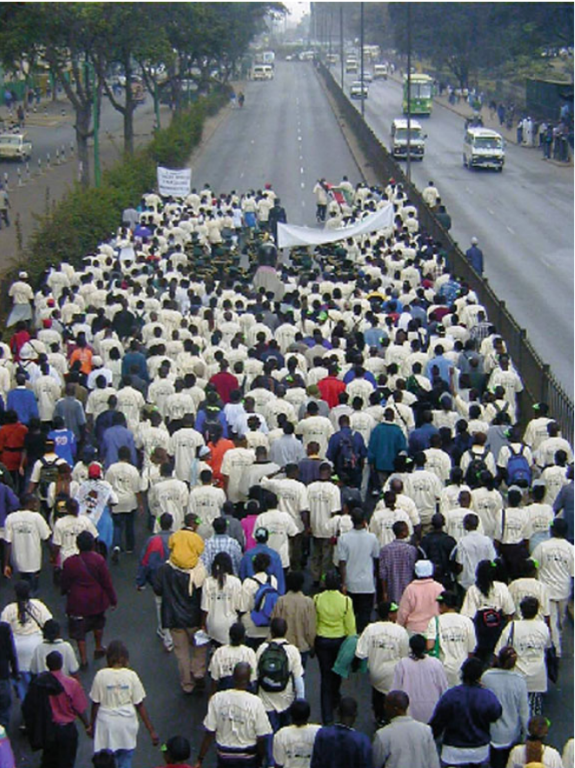
Restaurants started to include vegetables in their menus. As attitudes had changed and stigma turned into pride, the once neglected traditional vegetables became an area of interest for development agencies and training and research institutions. Production and marketing slowly moved from city suburbs into rural areas. Up to 17 traditional vegetable species were now regularly sold in local markets. The years that followed saw many organisations, including NGOs and universities, come to the scene and implement projects on ALVs.
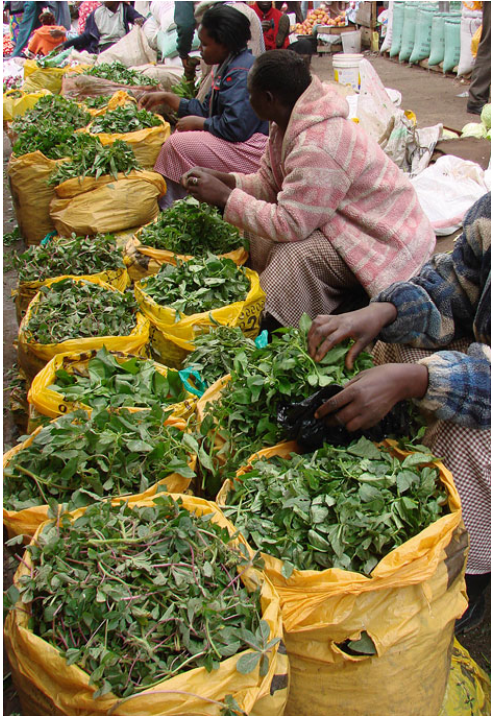
Post-Phase II Years and the Impact of the ALV Promotion
From 2008 to 2011, Bioversity International in partnership with the National Museums of Kenya and other organisations used a similar research and promotion approach in Kitui County located about 100 km east of Nairobi. One area within the county (Mwingi South) was chosen as the control site and Kitui Central as the intervention site. A baseline situation was established before the intervention. Neither the “control” nor the “intervention” markets sold traditional vegetables like the African nightshade and spider plant. After a year of promotional work in Kitui Central, a marked difference was noticeable. Attitudes in Kitui Central had changed, and more traditional vegetables were being cultivated and sold there. The diversity of vegetables in diets had also increased. The African nightshade, amaranth, and spider plant became mainstream traditional vegetables in Kitui Central (Kariuki et al., 2013) and only appeared on the “control” side at least a year later and also after an end-line intervention.
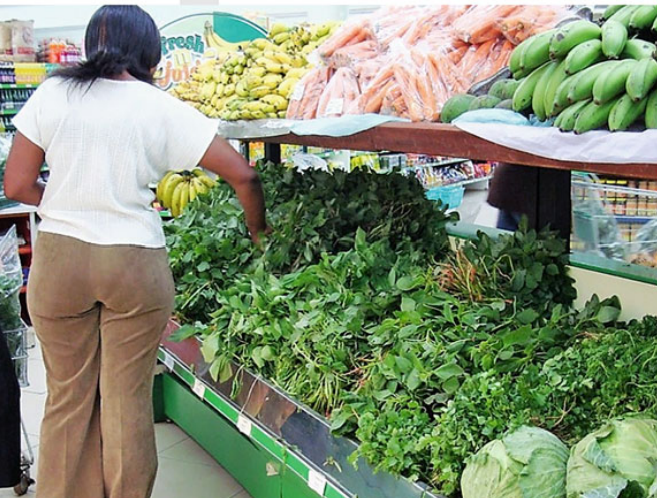
The above work is a clear demonstration that, with awareness and promotion, neglected and underutilised species can again become part of local diets, contributing to nutrition, health, and incomes, particularly among peri-urban women. The involvement of a multidisciplinary research and development team is a key factor to success. This work on ALVs has been evaluated by a number of individuals and organisations interested in specific aspects of the outcomes. An impact assessment conducted in 2006 and 2007 positively attributed increased production, marketing, and consumption to the work of the consortium. The women-dominated industry saw increased incomes for peri-urban women producers and city vendors. Nearly two-thirds (62.5%) of households growing ALVs increased their income from the sale of ALVs, while nearly half increased their consumption of ALVs. The assessment further found that interest in ALVs had increased among researchers, producers, traders, development workers, and consumers. Seeds had become more accessible, and increased cultivation of previously wild species was also observed. Traditional knowledge about the vegetables and associated practices had been revived (Gotor & Irungu, 2010).
3.2 Case Study 2: Bottle Gourd (Kitete) Conservation
The bottle gourd project, which was implemented between 2000 and 2002, used the foodways documentation method to identify the diversity of bottle gourds, local management practices, and related knowledge and cultural practices in Kitui County and surrounding counties (Morimoto & Maundu, 2002). Using the documented information, the project raised awareness among local communities to create economic, cultural, and livelihood opportunities by increasing bottle gourd cultivation and incentivising maintenance of the unique bottle gourd diversity.
A community group, Kyanika Adult Women Group in Kitui County, was concerned about losing the diversity and indigenous knowledge (IK) of an important cultural species due to the introduction of plastic containers, and solicited support from scientists at Bioversity International and the National Museums of Kenya. Group members started to collect seeds of different landraces and to document the indigenous knowledge of all the diverse bottle gourd shapes and types—initially from group members, then from other communities in Kitui County, and finally from more distant counties where they had contacts. Scientists guided the process. The group was trained on documentation protocols including use of the camera and tape recorder. One of the greatest innovations of the group was initiating an activity whereby group members formed pairs and then travelled to their original parental homes, often in faraway and diverse places, to interview elderly parents and relatives and collect bottle gourd seeds from them. The purpose of the pairing was for the women to be seen as belonging to a group and also to provide support to one another. Upon returning, members shared their experiences with group members and compiled the information in a 700-page compendium about the species. Nearly 200 bottle gourd types (landraces) referred to by approximately 70 different local names were collected and catalogued for propagation in community fields (Morimoto & Maundu, 2002; Morimoto et al., 2005, 2008; Morimoto, 2010).
The group members grew both edible gourds and those used as containers, and shared seeds with neighbours and friends. They also established a kitete community museum within the village. The museum serves as a centre for storing and distributing bottle gourd seeds, and also for learning about the bottle gourd. Visitors include school children, scientists, and bottle gourd enthusiasts (Morimoto et al., 2010). In addition, the group, in partnership with the different stakeholders, learned skills for decorating the kitete and nzele (a half gourd used as a bowl) and began selling these items to restaurants and tourist centres (Fig. 10.12).
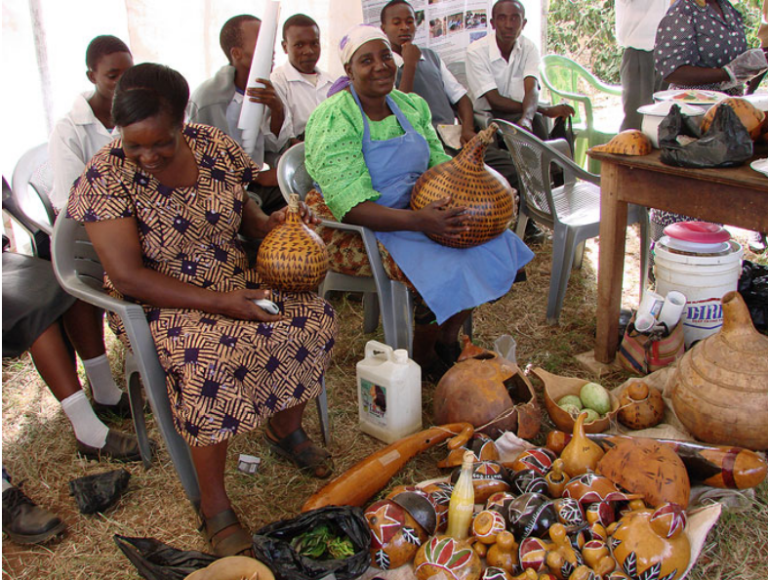
3.3 Case Study 3: Introducing Modern Technology to Educate Consumers on Diversifying Diet with Local Foods—The ADD-IT System
The ALV approach provided lessons that were later applied to promote dietary diversity in general. A study conducted by the team in Kitui County examined the link between food diversity (in the farm and wild landscapes), dietary diversity (at the household), and nutrition and health status of individuals. A set of 10 villages (the intervention villages) were exposed to promotional activities such as community seed fairs and seed exchanges, traditional food cooking demonstrations, and awareness-raising on nutrition for a period of 2 years (2009–2011). In another set of 10 villages (control villages) separated from the first by a mountain ridge, no promotional activities were carried out until after the two-year period had ended.
The study found that diversity (agro-biodiversity) at individual households in the intervention villages increased significantly between the baseline and final survey, while agro-biodiversity did not change much in the control villages. Dietary diversity at the household level showed the same trend. The study could not, however, establish a connection between the increased diversity at household level and any impacts on people’s health (Maundu, 2011; Herforth et al., 2019). The changes observed were attributed to the intervention activities. This work found that, despite communities having good access to diverse foods, poor dietary habits due to lack of awareness are sometimes to blame for poor nutrition. As was the case with ALV case study, awareness and education changed individuals’ food choices, especially incorporating more local foods in diet.
Based on the above experience, a new tool (an app) called the Agrobiodiversity Diet Diagnosis Interventions Toolkit (ADD-IT) was developed by the Alliance of Bioversity International and the International Center for Tropical Agriculture (CIAT) in partnership with the National Museums of Kenya and the Tokyo University of Agriculture, Japan.
The app utilises a newly developed, validated food frequency questionnaire(FFQ) to understand the food consumption patterns of the subject. Using a number of inbuilt datasets including a database on locally available foods, nutrient composition, and recommended daily nutrient allowance, the app is able to determine over and underconsumption of specific food groups. It then provides nutritional education using an inbuilt nutrition education facility which guides the subject through the steps to take in order to stay within the country’s dietary guidelines, but with specific emphasis on local foods (Induli, 2018; Irie et al., 2019).
ADD-IT thus (1) helps the subjects visualise their dietary patterns (i.e. deficiencies and excesses), (2) provides relevant real-time nutrition education based on what foods are available locally (in the community) at the time (season), and (3) stores the data in a web-based database system that can be used for further assessment.
The application is built mainly with community health workers in mind (Fig. 10.13) but will help any respondent(s) including households to understand their consumption habits. The overall data collected by the app at community level may help planners to initiate more targeted programmes to counter malnutrition or specific deficiencies at the community level. The application can also be used to accumulate new information on local food diversity. The creation of this tool involved public-private sector cooperation. A private company provided the technical support to create the app, and scientists provided the databases on which it runs, while health workers and extension staff tested the app and provided feedback for further improvement.
4 Discussion
This chapter has highlighted the significance of the foodways documentation approach in the identification of useful local food resources in local landscapes. We have also seen that foodways documentation itself is not the end, but rather a stepping stone to developing programmes that can benefit the community. Benefits in the form of income or better diets can act as incentives for communities to conserve and sustainably manage the local landscapes where these foods grow. In the case of the African leafy vegetables, the vegetable habitats and the species themselves were more appreciated when an economic aspect was introduced, and this gave the vegetables and their habitats some form of protection. The increased demand for the vegetables as a result of promotional activities spurred production and trade, thus creating more opportunities for income (especially for women who dominate vegetable cultivation and trading activities) and household nutrition.
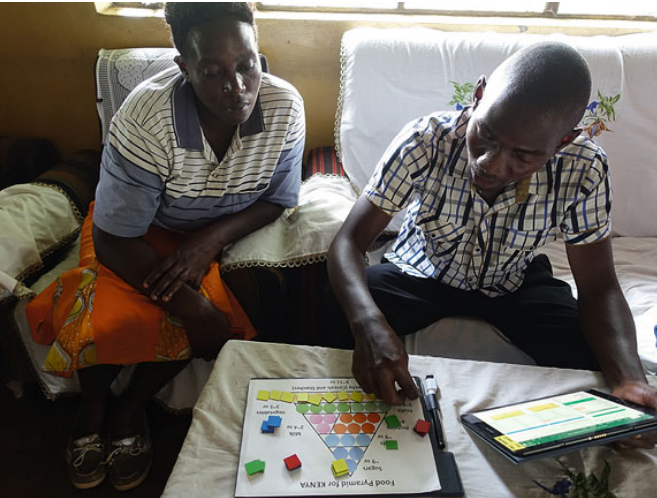
As seen earlier, the foodways documentation methodology helps us understand food in relation to other aspects of community culture. It is therefore less useful in situations where a community has significantly lost its culture and diversity. Community involvement, especially of the youth, is a key feature of the method. Much can be achieved when school children are mobilised as they can handle different aspects of the foodways. With the advancement and spread of digital tools and forums such as Facebook, Twitter, and YouTube, it will become even easier for the youth to share information on foodways.
The educational aspect of the ADD-IT tool builds upon data gathered from the foodways documentation. Aside from conservation and development opportunities, foodways documentation also opens up opportunities for nutrition research, such as the 24-h dietary recall and the food frequency questionnaire. The methodology is still being improved as the authors continue to test it in different production systems and cultures. Improvement is needed in the area of managing the massive amount of data that is churned out. Partnerships between communities and the private sector can create good synergies.
This chapter has also shown how the methodology has been applied at different levels of diversity—including the landscape, ecosystem, species, and variety levels. At the ecosystem level, foodways documentation has led to the empowerment of pupils and communities situated around the biodiversity-rich sacred Kaya forests of the Mijikenda and the Loita Maasai Forest, leading them to appreciate the diversity of their immediate ecosystem. In these cases, the communities have chosen to conserve wild areas as forestland rather than converting it to agricultural land—a case of balancing conservation and development objectives. Such well-conserved ecosystems (Maundu et al., 2001; NMK, 2008) are perfect examples of the multiple dimensions of health as they are not only a source of food and herbs for nutrition and health, but also a source of mental and spiritual health (many cultural ceremonies are held in the forest). The forests offer livelihood security through benefits such as water sources, non-timber forest products (e.g. honey), climate change mitigation and adaptation, and general community livelihoods (Maundu et al., 2001). As is with most conservation work, there are trade-offs. Increased selection of a species is likely to narrow the genetic pool of the species. However, with good management plans (e.g. promoting both wild and improved (selected) varieties on the basis of culinary strengths or preferences and cultural uses), these shortcomings can be overcome.
Moreover, this chapter has shown that community participation and leadership in documentation, as well as awareness on the value of local foods and cultural knowledge and practices, help in achieving ecosystem health, human health, and sustainability within socio-economic production landscapes (SEPLs) management (Bergamini et al., 2014; Morimoto et al., 2015; Mijatovic et al., 2018). Therefore, the effectiveness of SEPL management with respect to foodways can be measured through the following:
- Food diversity at the landscape level (diversity of production habitats, food diversity, household dietary diversity)
- Community benefits (income, health including mental and physiological, nutrition, cultural identity, general welfare)
- Community leadership and level of participation and interest (local champions, community support, and involvement in decision-making)
- Youth involvement (mentorship, youth in leadership)
4.1 COVID-19 Effects
In Kenya, the COVID-19 pandemic has had an unprecedented impact on the well-being of the people, not so much from infections and mortalities, but economically, socially, and psychologically. Lockdowns, restriction on movement, loss of jobs, higher cost of living, etc. have all taken a heavy toll on the people’s livelihoods. However, rural people who earn most of their livelihood from their immediate natural environment have been impacted much less by the pandemic than those in urban areas. This is a further demonstration that SEPLs can serve as the basis of resilience in local communities in the event of catastrophes and especially those affecting human health (Morimoto et al., 2015; Bedmar Villanueva et al., 2018; Dunbar et al., 2020). While this enhanced protection may be a result of plants providing a physical barrier and low population density, it could also be due to the healthy and diverse foods and herbal medicines in the environment, which the local people ingest daily, as well as their psychological status (Matsuda & Morimoto, 2020). The Maasai of Loita, for example, use diverse plants in soups and milk (key foods of the community) for health (Maundu et al., 2001). Some of the plants used for respiratory diseases in infusions are known to have antiviral and anti-inflammatory properties. The authors have observed that the COVID-19 pandemic has made many Kenyans more conscious about their health, and therefore it has pushed the demand for traditional vegetables, fruits, spices, and herbal teas higher, forcing many to grow their own healthy foods (Xinhua, 2020). These cases, and particularly the ALV and the ADD-IT projects, have a direct relevance to the COVID-19 pandemic as nutrition security is a short-term goal.
5 Conclusion
The case studies described herein have demonstrated not only the importance of foodways documentation in the sustainable management of rural landscapes, but also its role in community development, including ensuring human and ecosystem health. Foodways documentation is fundamental in development programmes that aim to maximise the benefits of landscape resources. Such programmes require multi-stakeholder action in collaboration with local communities as demonstrated in the three case studies. The studies have shown that multiple benefits to the communities serve as incentives for conservation and sustainable use (Maundu & Morimoto, 2011). Biodiverse community-managed landscapes such as the Loita Maasai Forest and Kaya sacred forests of the Mijikenda give multiple benefits including resilience for food security, nutritional and health benefits, good mental health, and prevention of infectious diseases like COVID-19. The cases provide insights on how foodways documentation approaches can contribute to sustainable management of natural resources, achievement of global biodiversity and sustainable development goals, and good health for all.
References
Bedmar Villanueva, A., Morimoto, Y., Maundu, P., Jha, Y., Otieno, G., Nankya, R., Ogwal, R., Leles, B., & Halewood, M. (2018). Perceptions of resilience, collective action and natural resources management in socio-ecological production landscapes in East Africa. In UNU-IAS & IGES (ed.) Sustainable use of biodiversity in socio-ecological production landscapes and seascapes (SEPLS) and its contribution to effective area-based conservation (, pp.14–25),
Satoyama initiative thematic review, vol. 4. United Nations University Institute for the Advanced Study of Sustainability
Bergamini, N., Dunbar, W., Eyzaguirre, P., Ichikawa, K., Matsumoto, I., Mijatovic, D., Morimoto, Y., Remple, N., Salvemini, D., Suzuki, W., & Vernooy, R. (2014). Toolkit for the indicators of resilience in socio-ecological production landscapes and seascapes. UNU-IAS, Biodiversity International, IGES & UNDP.
Dunbar, W., Subramanian, S. M., Matsumoto, I., Natori, Y., Dublin, D., Bergamini, N., Mijatovic, D., González Álvarez, A., Yiu, E., Ichikawa, K., Morimoto, Y., Halewood, M., Maundu, P., Salvemini, D., Tschenscher, T., & Mock, G. (2020). Lessons learned from application of the “Indicators of resilience in socio-ecological production landscapes and seascapes (SEPLS)” under the Satoyama initiative. In O. Saito, S. M. Subramanian, S. Hashimoto, & K. Takeuchi (Eds.), Managing socio-ecological production landscapes and seascapes for sustainable communities in Asia (pp. 93–116). Science for Sustainable Societies, Springer.
Google. (2015). Google maps, SW Burkina Faso, viewed 5 December 2015. Retrieved from https:// www.google.co.ke/maps/@11.0135609,-2.9839067,10.99z/data¼!5m1!1e1.
Google. (2016). Google Maps, Kenya, viewed 31 October 2016. Retrieved from https://www. google.co.ke/maps/@-0.275945,38.5953367,7z.
Google. (2020). Google maps, West, Central and East Africa, viewed 1 October 2020. Retrieved from https://www.google.co.ke/maps/@6.7311926,16.9259445,4.98z.
Gotor, E., & Irungu, C. (2010). The impact of Bioversity International’s African leafy vegetables programme in Kenya. Impact Assessment and Project Appraisal, 28, 41–55.
Hama-Ba, F., Parkouda, C., Thiombiano, N., Maudi, P., & Diawara, B. (2016). Recettes a base de legumes du couvert forestier livret de recettes traditionnelles a base de legumes du couvert forestier en pays Dagara au Burkina Faso. CIFOR, Bioversity International and IRSAT. Retrieved from https://www.cifor.org/publications/pdf_files/others/6586-booklet.pdf.
Herforth, A., Johns, T., Creed-Kanashiro, H. M., Jones, A. D., Khoury, C. K., Lang, T., Maundu, P., Powell, B., & Reyes-García, V. (2019). Agrobiodiversity and feeding the world: More of the same will result in more of the same. In K. S. Zimmerer & S. de Haan (Eds.), Agrobiodiversity: Integrating knowledge for a sustainable future (Strüngmann forum reports book 24) (pp. 185–211). The MIT Press.
Induli, I. (2018). Better data for better nutrition. Bioversity International, viewed 11 February 2021. Retrieved from https://www.bioversityinternational.org/news/detail/better-data-for-better-nutri tion/.
Induli, I. (2019a). Integrated participatory approach to improving dietary diversity. Panorama Solutions, viewed 11 February 2021. Retrieved from https://panorama.solutions/en/solution/ integrated-participatory-approach-improving-dietary-diversity.
Induli, I. (2019b). Enhancing use and conservation of food plant resources around sacred Kaya forests of the Mijikenda people of Kilifi, Mombasa and Kwale counties, Kenya. Panorama Solutions, viewed 11 February 2021. Retrieved from https://panorama.solutions/en/solution/ enhancing-use-and-conservation-food-plant-resources-around-sacred-kaya-forests-mijikenda.
Induli, I., Morimoto, Y., & Maundu, P. (2020). Researchers and entrepreneurs bring back forgotten gems: Underutilized crops transformed into healthy snacks. Biodiversity International, viewed 11 February 2021. Retrieved from https://www.bioversityinternational.org/ news/detail/researchers-and-entrepreneurs-bring-back-forgotten-gems-underutilized-crops-transformed/.
Irie, K., Morimoto, Y., & Maundu, P. (2019). Development of a new integrated ICT system tool (Agrobiodiversity and diet diagnosis for interventions toolkit: ADD-IT) for better decision-making in nutrition interventions. Journal of the Agricultural Society of Japan, 1651, 27–35. (in Japanese).
JAICAF. (2020). Introducing a new business using popping cereal technology in Kenya. YouTube, viewed 11 February 2021. Retrieved from https://www.youtube.com/watch?v¼8oM_D2 bxaYQ.
Johns, T., Powell, B., Maundu, P., & Eyzaguirre, P. B. (2013). Agricultural biodiversity as a link between traditional food systems and contemporary development, social integrity and ecological health. Journal of the Science of Food and Agriculture, 93(14), 3433–3442.
Kariuki, L., Maundu, P., & Morimoto, Y. (2013). Some intervention strategies for promoting underutilized species: Case of local vegetables in Kitui District, Kenya. Acta Horticulturae, 979, 241–248. Kenya National Bureau of Statistics (KNBS). (2014). Kenya demographic and health survey 2014, Nairobi, Kenya, viewed 10 November 2021. Retrieved from https://dhsprogram.com/pubs/pdf/ fr308/fr308.pdf
Kilifi Udamaduni Conservation Group. (2010). In P. Maundu, Y. Morimoto, & E. Towett (Eds.) Mboga za watu wa Pwani (Vegetables of coastal people of Kenya). Bioversity International, viewed 10 November 2021. Retrieved from http://www.bioversityinternational.org/fileadmin/_ migrated/uploads/tx_news/Mboga_za_Watu_wa_Pwani_1515.pdf (in Kiswahili).
Matsuda, H., & Morimoto, Y. (2020). Linkage between natural resource, agriculture, nutrition, and health toward sustainable society. AgriBio (pp. 67–70), Hokurikukan, New Science Co. Ltd. (in Japanese).
Maundu, P. M., Ngugi, W. G., & Kabuye, H. S. C. (1999a). Traditional food plants of Kenya. National Museums of Kenya.
Maundu, P. M., Njiro, E. I., Chweya, J. A., Imungi, J. K., & Seme, E. N. (1999b). The biodiversity of traditional leafy vegetables in Kenya. In J. A. Chweya & P. B. Eyzaguirre (Eds.), The biodiversity of traditional leafy vegetables (pp. 51–83). International Plant Genetic Resources Institute.
Maundu P., Berger, D., Saitabau, C., Nasieku, J., Kipelian, M., Mathenge, S., Morimoto, Y., & Hoft, R. (2001). Ethnobotany of the Loita Maasai: Towards community management of the forest of the lost child—Experiences from the Loita ethnobotany project. People and Plants Working Paper 8. UNESCO.
Maundu, P. (2002). Opportunities for higher nutritional benefits. Leaflet, International Plant Genetic Resources Institute.
Maundu, P., Grum, M., Morimoto, M., Eyzaguirre, P., & Johns, T. (2008). Diet diversification through local foods: Experiences from traditional vegetable promotion work in Kenya. In Poster presented at the international forum EcoHealth 2008, Merida, Yucatan, Mexico, 1–5 December.
Maundu, P., Achigan-Dako, E., & Morimoto, Y. (2009). Biodiversity of African vegetables. In C. M. Shackleton, M. W. Pasquini, & A. W. Drescher (Eds.), African indigenous vegetables in urban agriculture (pp. 65–104). Earthscan.
Maundu, P. (2011). Managing agricultural biodiversity for better nutrition and health, improved livelihoods and more sustainable production systems in sub-Saharan Africa: Case studies from Benin, Kenya, and South Africa. International Development Research Centre, viewed 10 November 2021. Retrieved from http://hdl.handle.net/10625/47124.
Maundu, P., & Morimoto, Y. (2011). Reconciling genetic resources and local knowledge conservation and livelihoods enhancement in research and development: Experiences of biodiversity International in sub-Sharan Africa. Biodiversity, 9(1), 56–60.
Maundu, P., Muiruri, P., Adeka, R., Ombonya, J., Morimoto, Y., Bosibori, E. Kibet, S., & Odubo, A. (2013c). Safeguarding intangible cultural heritage: A photobook of the traditional foodways of the Isukha and East Pokot communities of Kenya. UNESCO, viewed 10 November 2021. Retrieved from https://www.bioversityinternational.org/e-library/publications/detail/ safeguarding-intangible-cultural-heritage-a-photobook-of-traditional-foodways-of-the-isukha and-eas/.
Maundu, P., Kapeta, B., Muiruri, P., Morimoto, Y., Bosibori, E., Kibet, S., & Odubo, A. (2013a) Safeguarding intangible cultural heritage: Traditional foodways of the East Pokot community of Kenya. UNESCO, viewed 10 November 2021. Retrieved from https://www. bioversityinternational.org/e-library/publications/detail/safeguarding-intangible-cultural-heri tage-traditional-foodways-of-the-east-pokot-community-of-kenya/.
Maundu, P., Muiruri, P., Adeka, R., Ombonya, J., Morimoto, Y., Bosibori, E. Kibet, S., & Odubo, A. (2013d). Safeguarding intangible cultural heritage: Traditional foodways of the Isukha community of Kenya. UNESCO, viewed 10 November 2021. Retrieved from https://www. bioversityinternational.org/e-library/publications/detail/safeguarding-intangible-cultural-heri tage-traditional-foodways-of-the-isukha-community-of-kenya/.
Maundu, P., Bosibori, E., Kibet, S., Morimoto, Y., Odubo, A., Kapeta, B., Muiruri, P., Adeka, R., & Ombonya, J. (2013b). Safeguarding intangible cultural heritage: A practical guide to documenting traditional foodways. UNESCO, viewed 10 November 2021. Retrieved from https://www.bioversityinternational.org/e-library/publications/detail/safeguarding-intangible cultural-heritage-a-practical-guide-to-documenting-traditional-foodways/.
Mijatovic, D., Hodgkin, T., Pawera, L., Meldrum, G., Jarvis, D., Sthapit, S., Zira, S., Morimoto, Y., Maundu, P., Álvarez, A., Tarraza, A., Palikhey, E., Azhdari, G., Gruberg, H., Wakkumbure, L., Salimi, M., Estrada-Carmona, N., Shabong, R., & Maneerattanachaiyong, S. (2018). Assessing agrobiodiversity a compendium of methods. Platform for Agrobiodiversity Research.
Mkuu, R. S., Epnere, K., & Chowdhury, M. (2018). Prevalence and predictors of overweight and obesity among Kenyan women. Preventing Chronic Disease, 15(4), E44.
Morimoto, Y., & Maundu, P. (2002). Community-based documentation of indigenous knowledge (IK), awareness and conservation of cultural and genetic diversity of the Bottle Gourd (Lagenaria siceraria) in Kitui District, Kenya. In Poster presented at the Deutscher Tropentag workshop 2002, Challenges to organic farming and sustainable land use in the tropics and subtropics, University of Kassel, Witzenhausen, Germany, 9–11 October 2002. Retrieved fromhttps://www.tropentag.de/2002/abstracts/posters/158.pdf.
Morimoto, Y., Maundu, P., Fujimaki, H., & Morishima, H. (2005). Diversity of landraces of the white-flowered gourd (Lagenaria siceraria) and its wild relatives in Kenya: Fruit and seed morphology. Genetic Resources and Crop Evolution, 52(6), 737–747.
Morimoto, Y., Maundu, P., & Eyzaguirre, P. (2008). The bottle gourd: Its origin, travels round the globe with man and cultural influences on its fruit characteristics. In Poster presented at the International Symposium of Jack Harlan II, UC Davis, California, USA, 13–19 September 2008, viewed 10 November 2021. Retrieved from https://cgspace.cgiar.org/bitstream/handle/10 568/67528/Morimoto_thebottlegourd.pdf?sequence¼1&isAllowed¼y.
Morimoto, Y., Maundu, P., Tumbo, D., & Eyzaguirre, E. (2010). How farmers in Kitui use wild and agricultural ecosystems to meet their nutritional needs (Kenya). In C. Belair, K. Ichikawa, B. Y. L. Wong, & K. J. Mulongoy (Eds.) Sustainable use of biological diversity in socio-ecological production landscapes: background to the ‘Satoyama Initiative for the benefit of biodiversity and human well-being. Secretariat of the Convention on Biological Diversity, CBD Technical Series no. 52, pp. 67–72.
Morimoto, Y. (2010). Countering local knowledge loss and landrace extinction in Kenya: The case of the bottle gourd (Lagenaria siceraria), Case 37. In L. Maffi, & E. Woodley (Eds.) Biocultural diversity conservation: A global source book (pp. 33–35). Earthscan Publications Ltd.
Morimoto, Y., Maundu, P., Mijatovic, D., Bergamini, N., & Eyzaguirre, P. (2015). Assessing farmers’ perception of resilience of socio-ecological production landscapes in central and eastern Kenya. In UNU-IAS & IGES (Ed.), Enhancing knowledge for better management of socio-ecological production landscapes and seascapes (SEPLS) (Satoyama initiative thematic review) (Vol. 1, pp. 96–106). United Nations University Institute for the Advanced Study of Sustainability.
NMK. (2008). The sacred Mijikenda Kaya forests. National Museums of Kenya, Nairobi, viewed 10 November 2021. Retrieved from https://whc.unesco.org/uploads/nominations/1231rev.pdf. Xinhua. (2020). Kenyan herbs exports to increase in 2020 amid COVID-19 pandemic.
Xinhua, 14 November, viewed 14 May 2021. Retrieved fromhttp://www.xinhuanet.com/english/2020- 11/14/c_139514478.htm.
Note
The opinions expressed in this chapter are those of the author(s) and do not necessarily reflect the views of UNU-IAS, its Board of Directors, or the countries they represent.
Open Access This chapter is licenced under the terms of the Creative Commons Attribution 3.0 IGO Licence (http://creativecommons.org/licenses/by/3.0/igo/), which permits use, sharing, adaptation, distribution and reproduction in any medium or format, as long as you give appropriate credit to UNU-IAS, provide a link to the Creative Commons licence and indicate if changes were made.
The use of the UNU-IAS name and logo, shall be subject to a separate written licence agreement between UNU-IAS and the user and is not authorised as part of this CC BY 3.0 IGO licence. Note that the link provided above includes additional terms and conditions of the licence.
The images or other third party material in this chapter are included in the chapter’s Creative Commons licence, unless indicated otherwise in a credit line to the material. If material is not included in the chapter’s Creative Commons licence and your intended use is not permitted by statutory regulation, or exceeds the permitted use, you will need to obtain permission directly from the copyright holder.

